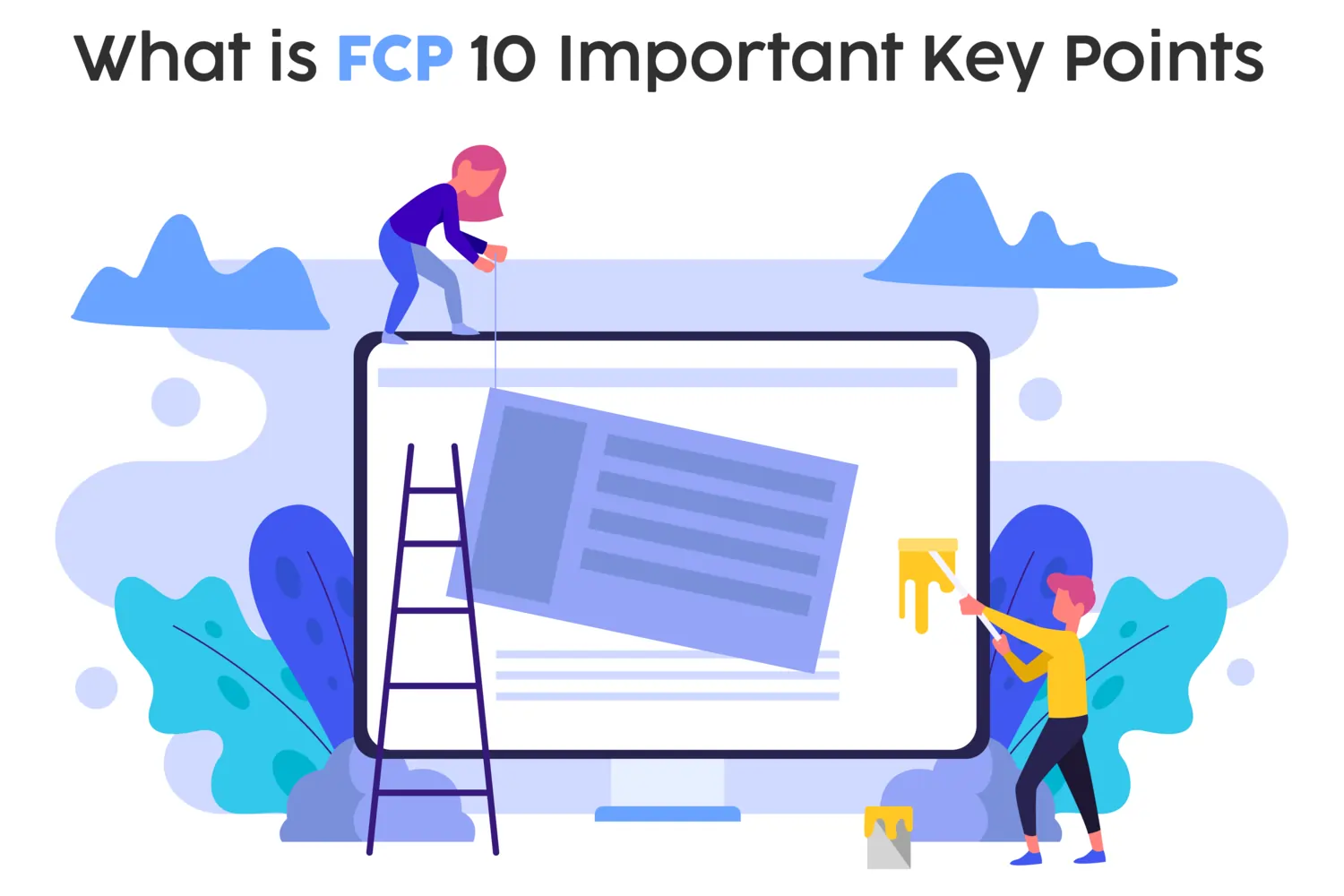First Contentful Paint (FCP) measures the time from when a page starts loading to when any part of the page's content is rendered on the screen.
Highlights
An enthusiastic developer and skilled business management expert with over a decade of experience in the field

First Contentful Paint (FCP) is the first significant event that happens in web page rendering and is widely used when measuring web page performance with the help of tools provided by Google’s Core Web Vitals. Browser rendering begins as soon as a user starts loading a page; this measures the time it takes for the first piece of content to appear on the screen. These could be text, images, or any other aspects such as the background or logo among others. FCP is a very accurate measure of how fast the user perceives the page to be loading which in turn is an important factor in gaining people’s attention and engagement with content on the page.
If you’re not familiar with FCP, here are 10 things you need to know about it in this blog so that you can master why it is relevant and how to enhance it.
FCP is all about the user's first visual experience with your website. The first impression of the site is very important because often the first thing users see on the page defines how fast they think the site is and what it looks like. If the first content is displayed at once, users sense that the page is loading fast even if other elements take a little longer.
Is your website outdated? Discover key signs that indicate it's time for a website redesign!
FCP is not just an indication of efficiency but a measure that affects the users of the system. It was found that for a user, it is not okay for a website to take more than 3 seconds to load. A fast FCP can therefore be a solution for retaining visitors and thereby minimizing bounce rates.
First of all, one should consider the importance of the first impression in the world of bytes and symbols. Measures included in a good FCP mean that the users will spend more time on your site, visit more pages, and have a satisfactory experience.
Although FCP is crucial, it is one element of a broader set of performance metrics. For instance, Largest Contentful Paint (LCP) quantifies the time it takes to load the main content, while Cumulative Layout Shift (CLS) evaluates visual stability.
FCP particularly refers to the time it takes for the first piece of content to be painted into the viewport, which is different from waiting for the major elements to be loaded or content that is not moving around on the screen. The differentiation is useful in determining which of the two should be given more emphasis when measuring various elements of organizational performance.
Because Google has made FCP one of its ranking factors together with other Core Web Vitals, poor FCP will reduce your web page ranking. If you have a faster FCP, the site will be ranked higher by Google. This is because when working with mobile devices users are less patient.
Here we see that a slow FCP can damage SEO even if the content of a page is perfect. Ms. Adwords insisted that Google aims at guaranteeing only the best user experience the sites to be ranked high by Google are supposed to load fast. As a result, the necessity of increasing FCP is important for the activation of users and for enhancing organic visibility at the same time.
FCP can be measured using tools like:
Google PageSpeed Insights: This tool returns dimensions for both the mobile and the normal version of your site along with FCP.
Lighthouse: Lighthouse works with the Chrome DevTools as a part of it and provides with the performance audits, FCP included.
Web Vitals Extension: This is a Chrome extension tool that helps in providing real-time metrics on CWV i.e. the FCP.
Google Search Console: The “Core Web Vitals” section, moreover, shows exactly how your site fares on the FCP, aside from other Web Vitals indicators.
Offers you analysis and suggestions on the numerous components that make up the FCP score.
Several factors influence FCP, including:
Server Response Time: Due to slow server response, the content takes time to fully load.
Render-Blocking Resources: Resources such as CSS, JavaScript, and any other resource capable of preventing the page from rendering can cause FCP delays.
Image Optimization: Huge images compressed improperly reduce loading speed, and consequently, FCP is affected.
Font Loading: The use of customized fonts can hinder the rendering process of text and consequently, FCP.
To improve FCP, consider the following strategies:
Use a Content Delivery Network (CDN): CDNs store your website’s files in multiple regions and thus can provide the user with the content of a site from a nearby server.
Optimize server infrastructure: It is better to select a stable hosting provider and adjust the settings of a server to minimize delays.
Implement caching: Browser caching and server-side caching make sure that many accessed resources are delivered in a faster way.
Optimize images for mobile: Make a way of using images that can be optimally responded to the user’s device and consequently minimize the file sizes.
Minimize third-party scripts: On mobile devices that can drastically affect your FCP as third-party scripts like ads or analytics may be loading. This meant loading scripts that are critically used first before the other scripts and pages which may not be of much use for some time.
Use adaptive design: This website design concept makes use of a responsive design because the content should load quickly on a pc as well as a mobile device and there is no need for an application to be loaded.
Minifying CSS and JavaScript files: This reduces the size and amount of time that is required to download the files.
Using async or defer for JavaScript: This will enable JavaScript to begin loading without stopping the rendering of the page.
Inlining critical CSS: This is especially important for above-the-fold content, to make sure that any CSS that will be needed to render it is loaded quickly, and on hand.
Discover the future of e-commerce! Explore emerging technologies and trends shaping the industry today!
Many websites have managed to enhance their FCP with the result being enhanced interaction with their users and increased rankings. For instance:
eCommerce Sites: An Internet retailer increased its FCP by reducing image size and avoiding uncontrolled JavaScript and, therefore, achieved a 10% lift in the conversion rate.
News Websites: Through pre-loading text content and delaying scripts that are not essential, a news site was able to cut its FCP in half and consequently, the users spent more time on the site.
Thus, with the changes that web technologies are seeing in the future, FCP will only grow in importance. In current web design, users visit a website via mobile devices that are connected to an internet connection with different speeds, so a fast FCP is important.
Web developers are beginning to pay particular attention to optimizing FCP as part of compound performances. Therefore, an expectation could be made about further focusing on the tools, frameworks, and best practices to help reach the fast FCP scores more easily.
Finally, FCP is not just a technical metric; it is a business-critical factor. Thus, increased FCP speed can also result in a higher user retention rate, increased engagement or clicks, and more conversions. It was found that organizations that operate with a focus on FCP are likely to have better customer satisfaction levels and overall business performance.
First Contentful Paint (FCP) is one of the essential performance indicators that influence both the user experience and SEO results. By understanding the key factors that influence FCP and implementing these tips, you can significantly reduce the time it takes for your site to display its first piece of content. First, it relates to optimizing a server response time and, second, reducing render-blocking resources, third, improving the start’s mobile performance, and, last but not least, applying a lazy loading strategy also matters as each of the strategies is crucial in providing faster and more efficient websites.
Optimizing FCP not only gives a better experience to the visitors but is also useful to keep the users engaged, increasing the conversion ratio along with better SERP rankings. Thus, integrating FCP as one of the approaches to optimizing websites will guarantee the successful option of a website for all categories of users.
At Digittrix, we know that a fast First Contentful Paint (FCP) is important for a good user experience. Our team works to make your website load as quickly as possible. We look at your site to find and fix things that might delay when your content first appears. Whether it’s speeding up your server or fixing things that slow down your site, Digittrix is here to help you get a better FCP, rank higher on Google, and provide a better experience for your visitors.
If you too want to Improve your website FCP and other important elements and are unsure of how to begin the process, schedule your appointment or book your consultation today with our expert technical managers by calling +91 8727000867
or write to us for all your queries at digittrix@gmail.com

Do you need help in Mobile App development?




Join over 1500+ businesses we've already helped!
FCP is a Web performance indicator that quantifies the wait time that a user experiences while the initial content is being downloaded and rendered beyond the moment the loading process has begun.
FCP is essential because it impacts the first impression about the speed at which the website loads which in turn impacts the engagement level of those who visit the website and the search engine ranking of the website.
FCP records the time it takes for the first content to be seen, LCP the time till the main content is completely loaded and CLS tracks the amount of page scroll needed before the content is stable.
FCP can be measured using various tools and applications among which are Google PageSpeed Insights, Lighthouse as well as WebPageTest; these tools provide analysis reports on FCP and further recommendations on the same.
There are several things that will affect FCP such as the server response time, render-blocking resources, which are things like JavaScript and CSS, Image optimization as well as fonts.

©2025Digittrix Infotech Private Limited , All rights reserved.